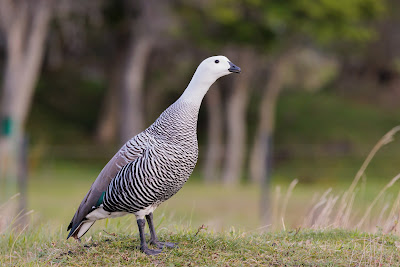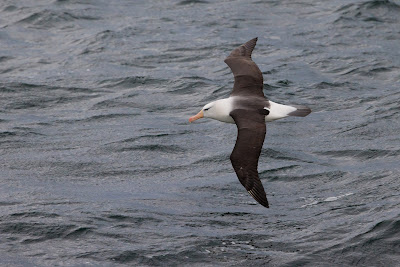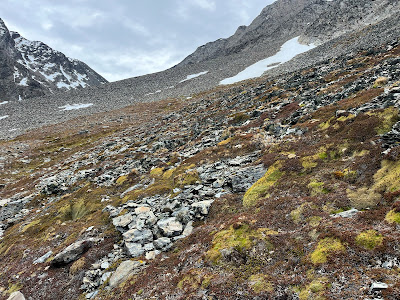Nov 2
We were itching to begin our Tierra del Fuego birding and had no trouble getting out quickly this morning. We began with the mouth of the Rio Pipo and three lifer Chloephaga geese straight away: UPLAND, ASHY-HEADED, and KELP. There was lots more to see. We completed our steamer-duck trifecta with several FLIGHTLESS STEAMER-DUCKS nearly side-by-side with FLYING.
 |
| Upland Goose |
To keep the unique waterfowl theme going, CRESTED DUCKS lined the sandbar, and a handful of CHILOE WIGEON were hanging by the channel. Both MAGELLANIC and BLACKISH OYSTERCATCHERS were present and vocal. AUSTRAL NEGRITOS flitted through the weeds. I was particularly distracted by a certain iconic Southern Cone species: DOLPHIN GULL.
 |
| Dolphin Gull |
When we allowed our gazes to drift beyond the coastline and into the Beagle Channel beyond, we had our first glimpses of CHILEAN SKUA and SOUTHERN FULMAR. But we would get much better views of those later in the day.
Surprisingly interesting in real life were the "Dusky" BLACK-CROWNED NIGHT-HERONS, not looking at all like the ones we saw around San Clemente earlier in the trip. Everything is different down here.
This morning's focus, though, would be Tierra del Fuego National Park. So we pulled ourselves away from the coast and drove west. The Old Growth forest inside the park was impressive and certainly felt different from any place I had been before. We worked our way down the main park road to its end, stopping wherever we saw/heard activity.
Our first mixed flock contained a few locally common passerines including WHITE-CRESTED ELAENIA, THORN-TAILED RAYADITO, and AUSTRAL THRUSH. The standout bird there was a WHITE-THROATED TREERUNNER, which is sorta like a nuthatch on steroids.
 |
| White-throated Treerunner |
 |
| White-crested Elaenia |
A bit further down we got another flock going, and in swooped a female MAGELLANIC WOODPECKER! We pieced together nice views of her in the depths of the forest. This is a "must see" species for anyone visiting this part of the world and we felt lucky to find one so quickly.
The habitat opened up and became wetter as we approached the Rio Lapataia, and from a roadside swamp we heard calling our first MAGELLANIC SNIPE. After some scouring of the banks we finally spotted it in the open and watched for quite a while. As we were enjoying the snipe, we were interrupted by PATAGONIAN SIERRA FINCHES, a more vibrant close relative of the Gray-hoodeds we saw further north. And across the road appeared a FIRE-EYED DIUCON, a sharp-looking flycatcher with a bright red iris.
Perhaps the scarcest bird we were hoping to see in the park is Spectacled Duck, an uncommon southern Andean species that is at the extreme southern limit of its range here. While checking a beaver pond for that bird, an AUSTRAL PYGMY-OWL began calling from across the bog and eventually came in to our whistling.
 |
| Austral Pygmy-Owl |
 |
| Upland Geese |
 |
| Chimango Caracara |
Meanwhile the sun was getting higher and one of the Daves spotted an ANDEAN CONDOR soaring high along the ridge line - a long anticipated life bird for yours truly. I missed that bird in Peru in 2021.
Not long after, Provencher picked up an adult BLACK-CHESTED BUZZARD-EAGLE on that very same ridge, a lifer for him that was also high on his list.
As we worked our way back along the main road, we pulled over to see another female MAGELLANIC WOODPECKER working near her nest hole. We heard a drum further into the forest, presumably from the male, but he remained out of sight.
 |
| Magellanic Woodpecker |
While watching the woodpecker, another highly sought-after species announced itself by vocalizing: AUSTRAL PARAKEET. After a bit of maneuvering we located a pair perched on a horizontal branch in the mid-canopy.
As you can see, we had loads of new birds this morning including a few toughies. This called for a celebratory lunch at the park restaurant overlooking the Rio Lapataia. Soon it would be time for an afternoon on the Beagle Channel!
We boarded the "Ana B" for our 6-hour cruise to Isla Martillo and back. A strong west wind had kicked up, enough that we were worried the trip might be canceled, but it did not seem to be a concern for this catamaran designed to cut through the chop.
 |
| Ushuaia |
Soon after departure we had our first CHILEAN SKUAS and SOUTHERN GIANT-PETRELS. These were soon followed by SOUTHERN FULMARS and BLACK-BROWN ALBATROSS. These are the four seabird staples of the Beagle Channel, and each are likely to be seen from land with a scope.
As we approached a set of islands south of town, a few dapper SOUTH AMERICAN TERNS became more obvious, and IMPERIAL CORMORANTS buzzed around us. One particular rocky islet held a bunch of bright white dots that soon declared themselves as SNOWY SHEATHBILLS, a bizarre and downright ugly bird! One of them apparently took a liking to our vessel and decided to come say hi.




This seemingly random island was our only decent shot at a very hardy passerine that is difficult to see outside the Falkland Islands: BLACKISH CINCLODES. Though its entire range is quite restricted, there are two subspecies. The mainland birds, which we were hoping to see here, show a creamy base to the bill. The Falklands birds, known there as the "Tussacbird," are entirely dark-billed. At first the only small birds we were seeing on the rocks were WHITE-RUMPED SANDPIPERS. Soon, though, we noticed two distant cinclodes bounding from rock to rock in the direction of our boat. One of them was every bit as curious as the Sheathbill and also came aboard without a ticket. A crewmember informed us that the cinclodes board boats in search of freshwater.
 |
| Blackish Cinclodes |
Once we were done island hopping, we continued eastward. With the wind at our backs, the conditions were comfortable and dry. This was not a pelagic birding trip, so we were not detouring for birds en route. We simply saw whatever was in line with our transect. Most of the birds were distant, but we had some really satisfying passes by several individuals.
 |
| Chilean Skua |
 |
| Chilean Skua |
 |
| Southern Giant-Petrel |
 |
| Black-browed Albatross with Magellanic Penguin |
 |
| Black-browed Albatross |
 |
| Black-browed Albatross |
 |
| Southern Fulmar |
 |
| Black-browed Albatross |
 |
| Black-browed Albatross |
 |
| Black-browed Albatross |
 |
| Black-browed Albatross |
 |
| Chilean Skua |
The Beagle Channel is only about 2-3 miles wide for much of this stretch, so we were also seeing birds in Chilean waters. We technically crossed the border for a brief time.
As we approached Isla Martillo, the GENTOO PENGUIN colony became visible. Right in the middle of that tight group were two KING PENGUINS (score), an iconic species that has become expected at this site in recent years. The scattered MAGELLANIC PENGUINS made this a three penguin stop!
 |
| King Penguins amongst Gentoos |
MAGELLANIC CORMORANTS were dominant over IMPERIALS here.
 |
| Magellanic Cormorant |
The big seabird target on this journey is Magellanic Diving-Petrel, which years ago would have been a guarantee but has become very scarce recently. With that in mind, we scheduled the two-way boat trip instead of the boat-then-bus loop, so we could have twice the time on the water to find this locally rare species. Both options are offered by multiple tour companies that run out of Ushuaia.
Our return trip was directly into the teeth of the wind, which wasn't a problem as far as stability goes. But as good as this boat was in rough seas, it was about as wet a ride as one could imagine. Even up top we were immediately soaked. It was completely unbirdable. All we could do was retreat to the cabin, where it looked like we were driving through a never-ending car wash.
We ended up dipping on the diving-petrel which was a bummer, but it was not for lack of trying! Day One in Tierra del Fuego felt like a massive success anyway.
Nov 3
There are two spots best-known to harbor White-bellied Seedsnipe during the breeding season: Martial Glacier near town and Garibaldi Pass up Route 3. The latter is more reliable, but the former is much easier to access. As we did not have reliable intel on Garibaldi access, we thought we would try Martial Glacier this morning. The seedsnipe might have been the biggest prize on the table, but there were other high-altitude species we hoped to find too.
As we walked the incline trail and broke above tree line, one of the first birds we saw was a WHITE-THROATED CARACARA flying against the mountaintop. This scarce and striking mountain raptor happens to be easy at the Ushuaia landfill, but it was way more fun to find our lifer in natural habitat.
In an attempt to divide and conquer, the three of us scattered and hiked the tundra-like scree in search of a seedsnipe that never materialized. But we did encounter several goodies along the way. OCHRE-NAPED GROUND-TYRANT was, to me, a surprisingly impressive bird. As Tripp put it, the bird's bright rear crown patch shone like a beacon, which is something that cannot be appreciated in illustrations.
 |
| Ochre-naped Ground-Tyrant |
Another ground-tyrant, this one DARK-FACED, made an appearance as well, though my views of that bird was never very satisfying.
YELLOW-BRIDLED FINCH is another specialty species up this high, and I had a ridiculously close encounter with a pair, one of which was singing from prominent rocks.
 |
| Yellow-bridled Finch |
Rounding out the list of new birds were a couple of BUFF-WINGED CINCLODES. We had a really enjoyable morning up here, even without the seedsnipe.
 |
| Buff-winged Cinclodes |
 |
| view of southern Ushuaia, the Beagle Channel, and Chile from the Martial Glacier |
 |
| Several folks were hiking up the snow fields and then skiing back down. Looked like a blast and a helluva workout... |
 |
| Lone skier still on the ascent. |
 |
| White-bellied Seedsnipe habitat...allegedly! |
The next move was to head back into the National Park and give the Spectacled Duck haunts another check, but we came up empty again. It was becoming apparent that we'd have to repeatedly hit the right habitat and get lucky to find them, which was certainly possible but not likely, as a pair had been reported only a couple times in the preceding weeks.
We did pick up a new bird in the park, a pair of DARK-BELLIED CINCLODES at Bahia Ensenada.
 |
| Dark-bellied Cinclodes |
With our remaining Ushuaia target list down to just a few toughies, we spent the afternoon poking along the coast between the park and city, as far east as Rio Pipo. The new bird of the afternoon was AUSTRAL BLACKBIRD, and there were duplicates of many species including our best looks yet at BLACK-FACED IBIS.
 |
| Austral Blackbird |
 |
| Black-faced Ibis |
 |
| Ashy-headed Geese |
 |
| Black-faced Ibis |
The river mouth wasn't quite as birdy as we had anticipated, undoubtedly due to the human disturbance along the water's edge. You might've noticed that I have not mentioned the local weather outside of a windy boat ride. That's because this notoriously wintry location had been anything but. In fact, each day had been warmer than the previous, and the locals had clearly caught spring fever. Temperatures today topped 60 degrees Fahrenheit! It wasn't quite Halter Top Day, but it was close! So much for those insulated ski pants I had packed...
- NB






































































Comments
Post a Comment